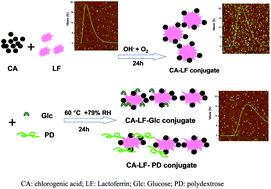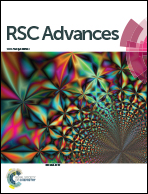Glycosylation improves the functional characteristics of chlorogenic acid–lactoferrin conjugate
Abstract
In the present study, a chlorogenic acid (CA)–lactoferrin (LF) conjugate prepared via alkali treatment was glycoslated with glucose (Glc) or polydextrose (PD) by the Maillard reaction. Formation of the covalent CA–LF–Glc/PD ternary conjugates was confirmed by matrix-assisted laser desorption/ionization time-of-flight mass spectrometry (MALDI-TOF-MS), Fourier transform infrared (FTIR) spectroscopy, differential scanning calorimetry (DSC) and fluorescence analyses. The results showed that the grafting ratio between the CA–LF conjugate and Glc/PD was 40.50% for the CA–LF–Glc ternary conjugate and 11.72% for the CA–LF–PD ternary conjugate. Conjugating CA and Glc/PD onto LF changed the conformation of the protein, leading to a reduction in the α-helix content and an increase in the unordered structure. The thermal stability of the CA–LF conjugate was remarkably improved by the Maillard-type conjugation. According to AFM and DLS results, the ternary conjugates showed coarser structures and bigger particle sizes than their mixtures. The reducing power was increased from 206.91 μmol Trolox g−1 of CA–LF conjugate to 255.76 and 273.25 μmol Trolox g−1 sample, respectively, in CA–LF–Glc and CA–LF–PD ternary conjugates, indicating the glycosylation was an effective way to improve the antioxidant activity of the CA–LF conjugate. Moreover, the ternary conjugates were employed to encapsulate β-carotene as a model biologically active macromolecule, and they could enhance the physicochemical stability of β-carotene emulsions. This work presented a simple and general approach to the preparation of polyphenol–protein–polysaccharide conjugates that could be potentially employed as food-grade biomacromolecules in the food and pharmaceutical industries.


 Please wait while we load your content...
Please wait while we load your content...